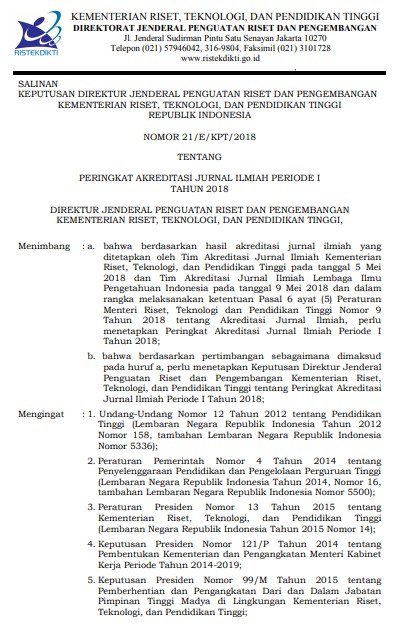A HIDDEN COST OF INDONESIA SINGLE RISK MANAGEMENT: SCRUTINY VIS A VIS SERVICES
Abstract
Trade facilitation services faces two major challenges which serves as a scrutiny and service. Erosion of scrutiny functions will pose a threat to national security, for instance food safety, goods forgery, fraud, and other form of transnational crimes. While the erosion of service function will impede the flow of goods which lead to economic injury. This paper will analyze to what extent Indonesia Single Risk Management is able to reduce the hidden cost in scrutiny vis a vis service. This is a normative study and employing statute approach, conceptual approach, and comparative approach. The data analysis used descriptive qualitative method. This study finds that harmonization of the determination of risk values and risk indicators in each Ministry/Agency can be used to minimize or manage hidden cost within trade facilitation.
Keywords: trade facilitation, risk management, service, scrutiny, hidden cost, customs.
Full Text:
PDF View
References
Bolhöfer, Carolin Eve. “Trade Facilitation – WTO Law and its Revision to Facilitate Global Trade in Goods”. Global Trade and Cus-toms Journal. Vol. 2 No. 11/12. Pp. 385-391. 2007. Pp. 38-56;
Chaturvedi, S. “Trade facilitation measures in South Asian FTAs: An overview of initia-tives and policy approaches”. Asia-Pacific Research and Training Network on Trade Working Paper Series. No. 28. January 2007. Pp. 1-47;
Doyle, Tom. “Collaborative Border Manage-ment” World Customs Journal. Vol. 4 No. 1. March 2010. Pp. 21-36;
Geourjon, Anne-Marie and Bertrand Laporte. “Risk management for targeting customs controls in Developing countries: a risky venture for revenue Performance?”. Public Admin. Dev. Vol. 25. 2005. DOI: 10.10 02/pad.336. Pp.113-123;
-------. “Customs and trade facilitation: from Concepts to implementation”. World Customs Journal. Vol. 2 No. 1. April 2008. Pp. 28-46;
-------. “Supply Chain Security: Adding To a complex operational and In-stitutional Environment”. World Customs Journal. Vol. 1 No. 2. September 2007. Pp. 27-32;
Grainger, Andrew. “Trade Facilitation: A Conceptual Review”. Journal of World Trade. Vol. 45 No. 1. 2011. Pp. 39-62;
Hesketh, David. “Weaknesses in the supply chain: who packed the box?”. World Cus-toms Journal. Vol. 4 No. 2. September 2010. Pp. 28-43;
IDB. 2010. “Risk Management for Cargo and Passengers A Knowledge and Capacity Product. Inter-American Development Bank Integration and Trade Sector. Tech-nical Notes. No. IDB-TN-29”. Available on http://www19.iadb.org/intal/intalcdi/PE/2011/ 08876.pdf.. accessed on 2 Janu-ary 2018;
Jüttner, Uta. Et.Al.. “Supply Chain Risk Man-agement: Outlining An Agenda for Future Research. International Journal of Logis-tics: Research and Applications”. Vol. 6 No. 4. 2003. Pp. 197-210. DOI: 10.1080/ 13675560310001627016;
Mikuriya, Kunio. “Supply Chain Security: The Customs Community’s Response”. World Customs Journal. Vol. 1 No. 2. Septem-ber 2007. p.58-64.
Miloshoska, Danijela and Ivica Smilkovski. “Se-curity and Trade Facilitation-The Evid-ence From Macedonia”. Horizonti. Vol. 19. 2017. Pp. 153-163. DOI: 10.20544/ HORIZONS.A.19.1.16.P14;
Neufeld, Nora. “Trade Facilitation Provisions in Regional Trade Agreements: Traits and Trends”. Journal of International Com-merce, Economics and Policy. Vol. 5 No. 2. 2014. Pp. 1-60. DOI: 10.1142/S1793993 314500057;
Tweddle, Doug. “Logistics. Security and Compli-ance: The Part to Be Played by Authorised Economic Operators (AEOS) and Data Management”. World Custum Journal. Vol. 2 No. 1. March. 2007. Pp. 105-123;
Widdowson, David. 2005. “Managing Risk In The Customs Context”. (Chief Executive Of-ficer. Centre for Customs and Excise Stud-ies and Adjunct Professor. School of Law. University of Canberra. Australia). Avail-able on: http://www.carecprogram.org/ uploads/events/2005/Risk-Management-Seminar/009_103_210_Day1-Managing-Risk-Customs-Context.pdf. accessed on February 1. 2017
Yang, Yi-Chih. “Risk management of Taiwan’s maritime supply chain security”. Safety Science. Vol 49. 2011. Pp.382-393. DOI: 10.1016/j.ssci.2010.09.019.
DOI: http://dx.doi.org/10.20884/1.jdh.2018.18.3.2123
Refbacks
- There are currently no refbacks.
JURNAL DINAMIKA HUKUM Indexed by :
 | Jurnal Dinamika Hukum | |
| Faculty of Law, Universitas Jenderal Soedirman | Copyright of Jurnal Dinamika Hukum | |
| Yustisia IV Building, Law Journal Center | ISSN 2407-6562 (Online) ISSN 1410-0797 (Print) | |
| Purwokerto, Central Java, Indonesia, 53122 | JDH is licensed under a Creative Commons Attribution 4.0 International License | |






